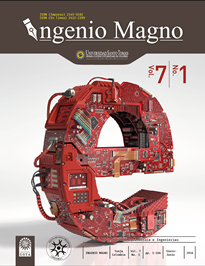Determination of degree of metallization of pellets from an iron mixture, reduced in a Linder furnace
Main Article Content
Abstract
Downloads
Article Details
DECLARATION OF ORGINIALITY OF SUBMITTED ARTICLE
With this document, I/We certify that the article submitted for possible publication in the institutional journal INGENIO MAGNO of the Research Center Alberto Magno CIIAM of the University Santo Tomás, Tunja campus, is entirely of my(our) own writing, and is a product of my(our) direct intellectual contribution to knowledge.
All data and references to completed publications are duly identified with their respective bibliographical entries and in the citations thus highlighted. If any adjustment or correction is needed, I(we) will contact the journal authorities in advance.
Due to that stated above, I(we) declare that the entirety of the submitted material is in accordance with applicable laws regarding intellectual and industrial property, and therefore, I(we) hold myself(ourselves) responsible for any complaint related to it.
If the submitted article is published, I(we) declare that I(we) fully relinquish publishing rights of the article to the University Santo Tomás, Tunja campus. As remuneration for this relinquishment of rights, I(we) declare my(our) agreement to receive two (2) copies of the edition of the journal in which my(our) article appears.
References
Alcázar, J. (2011). Influencia del contenido de sílice del mineral de hierro en la resistencia al impacto del material briqueteado en caliente. En Memorias de las IX Jornadas de Investigación 2011, UNEXPO. Puerto Ordaz: C.V.G. Ferrominera Orinoco.
Barbis, R. (2000). Reducción de minerales de hierro (conferencia). Tunja: Universidad Pedagógica y Tecnológica de Colombia.
Cores, A., Babich, A., Muñiz, M. y Mocho, J. (2010). The Influence of Different Iron Ores Mixtures Composition on the Quality of Sinter. Recuperado de https://www.researchgate.net/publication/250161720_ The_Influence_of_Different_Iron_Ores_Mixtures_ Composition_on_the_Quality_of_Sinter
Dwarapudi, S., Ghosh, T., Shankar, A., Tathavadakar, V., Bhattacharjee, D. y Venugopal, R. (2011). Effect of pellet basicity and MgO content on the quality and microstructure of hematite pellets. International Journal of Mineral Processing, 99, 43-53.
Forero P., A. y Díaz B. , S. (2007). Beneficio de una magnetita para producción de pellets utilizados en procesos de reducción directa. Scientia et Technica, 36, 793-796.
Formoso, A. (2000). Estudio de la granulación de la mezcla de minerales de hierro en el proceso de sinterización. I parte. Granulación. Revista Metalurgia, 36, 244-253.
Grupo de Siderurgia UPTC (2003). Diseño y construcción de un horno rotatorio a nivel de planta piloto para la obtención de prerreducidos a partir de minerales de hierro nacionales, en Acerías Paz del Río S.A. Tunja: Autor.
Gustafsson, G. (2013). Determination of bulk properties and fracture data for iron ore pellets using instrumented confined compression experiments. Powder Technology, 241, 19-27.
Macías, V., Camporredondo, J. y Soria, M. (2009). Análisis termodinámico del proceso de endurecimiento de pelet de mineral de hierro. Prospectiva, 7(1), 59-66.
Melgarejo, J. C. (2010). Técnicas de caracterización mineral y su aplicación en exploración y explotación minera. Boletín de la Sociedad Geológica Mexicana, 62(1), 1-23.
Nellros, F. (2011). Automated image analysis of ironore pellet structure using optical microscopy. Minerals Engineering, 24, 1525-1531.
Przemyslaw, F. y Mróz, J. (2011). Ability for SelfPelletization of Iron Ores and Magnetite Concentrates. Journal of Iron and Steel Research, International, 18(6), 1-7.
Wu, S., Wang, Q, Bian, M., Zhu, J. y Long, F. (2011). Influence of Iron Ore Characteristics on FeO Formation During Sintering. Journal of Iron and Steel Research, International, 18(5), 5-10.
Vásquez, J. (2010). El mineral de hierro en Venezuela. Caracas: Ministerio de Poder Popular para la Educación.
Yang, S., Zhou, M., Jiang, T., Wang, Y. y Xue, X. (2015). Effect of basicity on sintering behavior of lowtitanium vanadium−titanium magnetite. Transactions of Nonferrous Metals Society of China, 25, 2087-2094.
Zhu, D., Chun, T., Pan, J. y Zhang, J. (2013). Influence of basicity and MgO content on metallurgical performances of Brazilian specularite pellets. International Journal of Mineral Processing, 125, 51-60.

